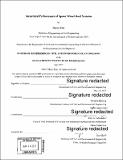Structural performance of spoke wheel roof systems
Author(s)
Kim, Harry, M. Eng. Massachusetts Institute of Technology
DownloadFull printable version (10.98Mb)
Other Contributors
Massachusetts Institute of Technology. Department of Civil and Environmental Engineering.
Advisor
Gordana Herning and John A. Ochsendorf.
Terms of use
Metadata
Show full item recordAbstract
A spoke wheel roof system consists of tension rings, compression rings, and radial spokes and resists loads mainly through axial forces. Due to its light weight and ability to achieve a column-free, long span, it has been a popular solution to structures such as stadia since its first use in 1960s. However, there has been lack of information on the performance of a spoke wheel roof system depending on its geometry. This thesis explores the history and general behaviors of a spoke wheel roof system. A representative model is created and tested in Rhino-Grasshopper-Karamba, and the geometric variations to the structure and their influence are evaluated. Configuration of the rings, inner and outer ring radii, aspect ratios of the rings, spoke spacing and slope are chosen to be variables, and load path is used as an evaluation criterion for structural performance or efficiency. Results show that the choice between different ring configurations depends on architectural needs and climate conditions. Assuming that minimal load path implies high structural performance, roof span and size are inversely related to the structural performance. They have a greater influence than the aspect ratios of the rings. Smaller spacing and larger slope of the spokes lead to a more efficient structure.
Description
Thesis: M. Eng., Massachusetts Institute of Technology, Department of Civil and Environmental Engineering, 2017. Cataloged from PDF version of thesis. Includes bibliographical references (pages 65-66).
Date issued
2017Department
Massachusetts Institute of Technology. Department of Civil and Environmental EngineeringPublisher
Massachusetts Institute of Technology
Keywords
Civil and Environmental Engineering.